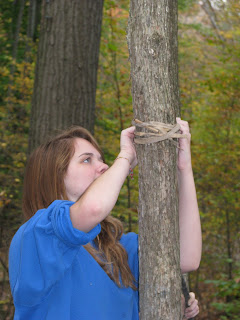Today was great! We are all exhausted from a full day of Land Art activities. After studying the Land Art movement of the 1960's and 70's, Advanced Studio in Art created site specific, ephemeral sculptures in the woods behind the high school. We specifically studied the works of Robert Smithson and Andy Goldsworthy.
Land Art is a form of contemporary art. Also known also as Earthworks, or Earth Art, this movement emerged when a number of sculptors and painters became determined to heighten public awareness of our relationship with the natural world by intervening in the landscape in a series of thought-provoking constructions.
These (frequently massive) land-based interventions or artworks took a variety of forms, from large-scale land artworks like man-made curtains reaching across vast stretches of landscape, the encirclement of whole islands in coloured fabric, and reshaped waterways and volcanoes, to simple lines of footprints in the earth.
Andy Goldsworthy, is a British sculptor, photographer and environmentalistproducing site-specific sculpture and land art situated in natural and urban settings. He lives and works in Scotland.The materials used in Andy Goldsworthy's art often include brightly-coloured flowers, icicles, leaves, mud, pinecones, snow, stone, twigs, and thorns. He has been quoted as saying, "I think it's incredibly brave to be working with flowers and leaves and petals. But I have to: I can't edit the materials I work with. My remit is to work with nature as a whole." For his ephemeral works, Goldsworthy often uses only his bare hands, teeth, and found tools to prepare and arrange the materials.
Robert Smithson is most well known for his provocative earthwork, the Spiral Jetty, made in 1970. This monumental earthwork was inspired in part when Smithson saw the Great Serpent Mound, a Pre-Columbian Indian monument in southwestern Ohio. The earthworks were a radical departure from making formal objects situated in a gallery setting.
http://www.robertsmithson.com/introduction/introduction.htm
Land Art is a form of contemporary art. Also known also as Earthworks, or Earth Art, this movement emerged when a number of sculptors and painters became determined to heighten public awareness of our relationship with the natural world by intervening in the landscape in a series of thought-provoking constructions.
These (frequently massive) land-based interventions or artworks took a variety of forms, from large-scale land artworks like man-made curtains reaching across vast stretches of landscape, the encirclement of whole islands in coloured fabric, and reshaped waterways and volcanoes, to simple lines of footprints in the earth.
Andy Goldsworthy, is a British sculptor, photographer and environmentalistproducing site-specific sculpture and land art situated in natural and urban settings. He lives and works in Scotland.The materials used in Andy Goldsworthy's art often include brightly-coloured flowers, icicles, leaves, mud, pinecones, snow, stone, twigs, and thorns. He has been quoted as saying, "I think it's incredibly brave to be working with flowers and leaves and petals. But I have to: I can't edit the materials I work with. My remit is to work with nature as a whole." For his ephemeral works, Goldsworthy often uses only his bare hands, teeth, and found tools to prepare and arrange the materials.
Robert Smithson is most well known for his provocative earthwork, the Spiral Jetty, made in 1970. This monumental earthwork was inspired in part when Smithson saw the Great Serpent Mound, a Pre-Columbian Indian monument in southwestern Ohio. The earthworks were a radical departure from making formal objects situated in a gallery setting.
Thanks again to our lovely Librarian, Mrs. Eustace for her help today!
http://www.robertsmithson.com/introduction/introduction.htm



















